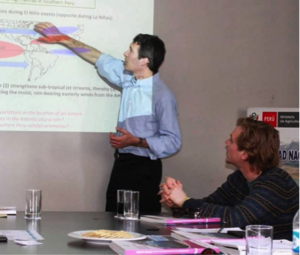Funding Agency: Southern Peru Copper Corporation
Award Period: 2016-2018
This international, multidisciplinary project aims to reduce the vulnerability of regional stakeholders to spatiotemporal precipitation variability. Located at a complex climatic, topographic, and hydrologic crossroads, southern Peru is a semi-arid region just north of the Atacama Desert with a high economic dependence on agriculture and mining activities. Water shortages in dry years deleteriously impact these economic activities and inflict stress upon regional urban centers. A season-ahead prediction model was developed using large-scale climate variables to predict regional JFM precipitation. Deterministic and categorical metrics were employed to evaluate the model and show that season-ahead predictions may provide additional, more accurate insight to decision makers over simpler methods, such as relying on climatology.
Ensemble hindcasts were developed for more than fifty years of regional precipitation data, showing a cross-validated correlation of 0.58 and a ranked probability skill score (RPSS) of 16%.
The model is currently being refined via the NIPA approach, developed by the WSS Group. Because of the strong relationship between regional precipitation and sea surface temperatures in the equatorial Pacific Ocean, it may be advantageous to consider the specific phase of ENSO in developing additional season-ahead prediction models.
Concurrently, research is being conducted on opportunities to incorporate forecast information into proactive emergency actions for farmers. In developing standard operating procedures for regional agricultural interests, the potential for risk reduction mechanisms such as forecast-based financing and index insurance becomes much more tangible.

Presenting project findings to stakeholders in Tacna, Peru (left). In dry years, water shortages cause deleterious economic impacts (right).


